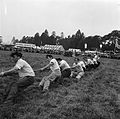This article needs additional citations for verification .(February 2024) |

The Royal Welsh Show (Welsh : Sioe Frenhinol Cymru) is an agricultural show, organised by the Royal Welsh Agricultural Society (originally, the Welsh National Agricultural Society, [1] formed 26 February 1904 by influential landowners, at Committee Room 12 at the House of Commons [2] [3] ), and first held in 1904. It takes place in July of each year, at Llanelwedd, near Builth Wells, in Powys, Mid Wales. [4]
Contents
- Format
- Business
- Young Farmers
- Welsh Cob Senior Stallions class
- Rail access
- See also
- References
- External links
The first show was held in Aberystwyth in 1904, on the Vicarage Field, [5]
Godfrey Morgan, 1st Viscount Tredegar was elected president of Welsh National Agricultural Society in 1913. [6] [7] [8]
On 22 November 1922, George V became Patron and the Edward VIII, Prince of Wales became Honorary President, and the name was changed to the Royal Welsh Agricultural Society. [5]
It was held in a different town, every year in July, alternating between the north and the south, with a permanent showground at Llanelwedd near Builth Wells, first used on 23 July 1963. [9] [10]
No show was held in 1915–18 (WWI), 1940–45 (WWII) nor 2020–21 (COVID-19 pandemic). The latter years saw some events going virtual.



